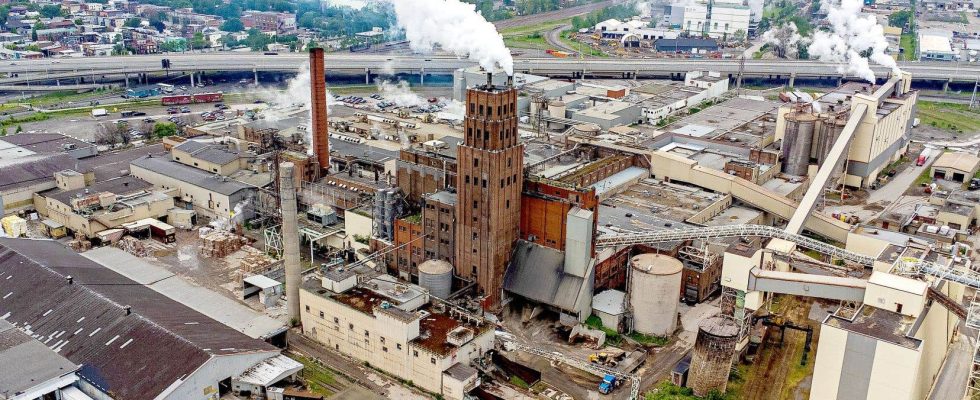The White Birch paper mill is more than a hair’s breadth in the “atmospheric soup” of Limoilou and the central districts of Quebec. A preliminary analysis accuses the plant of emitting large quantities of pollutants, both in the air and in the St. Lawrence, and blames the government for its laxity with regard to the American company.
The large chimneys of the paper mill spit out white smoke that has been part of the Quebec landscape for almost a century. The population of the lower town has long been accustomed to living with the comings and goings of trucks and the smell of sulphur, without however being aware of the danger the plant poses to their health.
“This factory is close to highly dense residential neighborhoods,” says Raymond Poirier, president of the Vieux-Limoilou district council. This plant finds itself in a context where there are major issues with respect to pollution. It is clear that this company must act to ensure a neighborhood of the best possible quality”.
Public data from the National Pollutant Release Inventory (INRP) paints “a worrying picture”, according to him, and makes it possible to know the nature and the quantity of ingredients that the White Birch adds to the “cocktail of pollution” concocted in the central neighborhoods by the Port, the highways, the incinerator and the smoke from derogatory wood stoves.
In 2021, the Quebec pulp and paper mill said it released 18.7 tonnes of ammonia and 43 kg of lead into the river. In addition to these releases into the water, there are those into the air: 283 tonnes of carbon monoxide (CO2), 178 tonnes of volatile organic compounds (VOCs) present in gasoline vapors and in solvents, in addition to 76 tons of nitrogen oxide and 60 tons of particulate matter.
“We are in an inadequate situation, an untenable situation,” repeats Raymond Poirier in the face of the large number of broadcasts.
An independent analysis report
The supportive deputy for Jean-Lesage, Sol Zanetti, agrees. Worried, like many of his fellow citizens, about the poor air quality in Quebec City’s lower town, he commissioned a specialist to highlight the public data available around the White Birch.
“There is a diffuse impression that what she rejects would not be so serious for health, explained the deputy. To get to the bottom of it, I asked an environmental expert to write an analysis report of the currently public data on the paper mill’s polluting emissions. »
“I am concerned,” the expert in question, Slavko Sebez, told the Duty. Its preliminary report contrasts emissions from the paper mill with those from the Quebec City incinerator, capable of processing up to 312,000 tonnes of waste per year.
According to his results, the White Birch plant emits 76 times more VOCs and five times more CO2. This is the equivalent, the report illustrates, of the total emissions of 12,744 cars traveling 10,000 km per year and of the particles emitted each hour by 2,328 certified pellet stoves.
“Even if the emissions from the White Birch met the standards, explains the expert in his report, the pollutants released by the plant are added to the emissions released by other sources nearby. Cumulative effects, he says, quoting the Canadian Council of Ministers of the Environment, “can be significant even if the effects of each action, assessed individually, are considered negligible. »
An opportunity to seize, according to the solidarity
Five years ago, the government issued a clean-up certificate to the White Birch. This document, considered by many as a “right to pollute” similar to that granted to the Horne smelter in Rouyn-Noranda, tolerates derogations from the environmental standards in force in Quebec law.
The Quebec paper mill can thus emit 100 micrograms of total suspended particles per m3. This is a tolerance five times greater than for the incinerator, limited to 20 micrograms per m3.
The renewal of the certificate attributed to the White Birch must take place in July. Solidarity Sol Zanetti asks the government to tighten the standards imposed on the factory, too lax, in his opinion, to ensure the safety and health of the neighborhood, in his opinion.
“The certificate, at present, it is not very strict and there are only total suspended particles and total reduced sulfur compounds which are standardized, specifies the deputy for Jean-Lesage. There is only one sampling campaign per year for a duration of 12 hours, which is also clearly insufficient. »
He is now asking that the government impose a tighter regulatory straitjacket on the plant, which has also received several notices of non-compliance concerning its discharges into wastewater in recent years.
“We never asked for anything from the White Birch. This industry, as long as we don’t ask it to do the maximum and raise the bar, it will continue to roll as it has rolled for decades to make the most possible profits. »
The duty had no return from the paper mill. Nor had the Minister of the Environment reacted when these lines were written.
In Limoilou, the population is now asking for leadership and, above all, consistency from the government. “If we had a very quick reaction to legislate on wood stoves, we expect the same type of reaction for this installation,” concluded Raymond Poirier, from the Vieux-Limoilou district council, while behind him , the chimneys clouded the sky.
